Posts Tagged ‘kids summer camp’
Missing our friends!
Tuesday, August 26th, 2014Kids, Clothes, and Chaos
Tuesday, April 5th, 2011We came across this blog and got a really good chuckle out of it. Since we’ve rounded that corner into April and the “waiting to pack” countdown has officially begun, we can’t resist sharing it with you. We would like to thank Lisa, the original author, for her permission to reprint it…
I am fortunate enough to be able to send my two older children to sleepaway camp. It is a fantastic learning, growing and 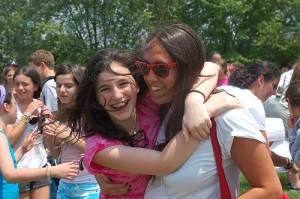 maturing experience – for me and them! My kids learn that the world still turns if they wear clothes that don’t match or the same shirt 4 days in a row, or what it’s like to meet new people, watch themselves become independent beings and experience things they never could at home (we don’t have a lake in our backyard or a kiln in the kitchen).
maturing experience – for me and them! My kids learn that the world still turns if they wear clothes that don’t match or the same shirt 4 days in a row, or what it’s like to meet new people, watch themselves become independent beings and experience things they never could at home (we don’t have a lake in our backyard or a kiln in the kitchen).
That said, there’s a lot of waiting involved with camp. It all starts with the waiting-to-pack time period. It’s incredible how much stuff needs to be stuffed 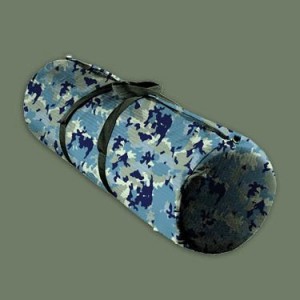 inside of the trunks that are taken to camp. Ok, first off, let’s not date ourselves to when they were actual black with gold rivet trunks – they’re really just duffle bags. Granted, huge, enormous, can hold at least 4 grown men duffles, but duffle bags nevertheless. And these duffles sit in my bedroom for weeks until they are actually picked up and taken away (given that we don’t have an extra bedroom and my husband and I’s room has the most space). So I wait as long as possible to unearth them from where they are stashed all winter to reduce the number of nights I can possibly slip, roll and kill myself on an errant battery or sunscreen stick that has escaped the double layered ziploc bag in which it was stored. Aside from my general safety, I have to wait to pack because nothing pisses me off more than putting items inside the bags and crossing them off my checklist, only to be asked the next morning by one of my chidlren if they can wear that shirt, jersey, soccer cleat, you name it, one last time. So, although I have a few friends that are happy to feel organized starting this process in February for a June pick-up, I’ll stick with the wait-until-the-last-minute crunch time way that seems to work best for us.
inside of the trunks that are taken to camp. Ok, first off, let’s not date ourselves to when they were actual black with gold rivet trunks – they’re really just duffle bags. Granted, huge, enormous, can hold at least 4 grown men duffles, but duffle bags nevertheless. And these duffles sit in my bedroom for weeks until they are actually picked up and taken away (given that we don’t have an extra bedroom and my husband and I’s room has the most space). So I wait as long as possible to unearth them from where they are stashed all winter to reduce the number of nights I can possibly slip, roll and kill myself on an errant battery or sunscreen stick that has escaped the double layered ziploc bag in which it was stored. Aside from my general safety, I have to wait to pack because nothing pisses me off more than putting items inside the bags and crossing them off my checklist, only to be asked the next morning by one of my chidlren if they can wear that shirt, jersey, soccer cleat, you name it, one last time. So, although I have a few friends that are happy to feel organized starting this process in February for a June pick-up, I’ll stick with the wait-until-the-last-minute crunch time way that seems to work best for us.
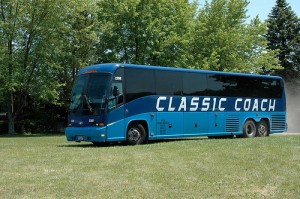 But the waiting doesn’t end with the pick-up of the bags. No siree. Then there’s the parking lot send-off where the parents stand in the middle of an open parking lot in midday. Blinking, shielding their eyes in the glaring heat (even behind the giant black Jackie-O glasses bought for the occasion) at a tinted window to try to catch a last glimpse of their child while trying to choke back emotion to “put on a good front”. Inevitably, there’s a late-comer who was stuck in traffic so us parents are left standing like beauty pageant idiots waving and waiting, waving and waiting.
But the waiting doesn’t end with the pick-up of the bags. No siree. Then there’s the parking lot send-off where the parents stand in the middle of an open parking lot in midday. Blinking, shielding their eyes in the glaring heat (even behind the giant black Jackie-O glasses bought for the occasion) at a tinted window to try to catch a last glimpse of their child while trying to choke back emotion to “put on a good front”. Inevitably, there’s a late-comer who was stuck in traffic so us parents are left standing like beauty pageant idiots waving and waiting, waving and waiting.
Once the bus pulls away then the wait for the first online picture begins. Can you say refresh button? You never know when new pics will be posted… And of course, the first letter (hopefully with no circled tear droplets or talk of homesickness and hitching a ride home) and the first phone call. Visiting Day can never arrive quickly enough and as soon as you pull away from camp, the countdown to their homecoming begins. And then there’s the the daily wait for the mailman in the hopes he brings some small tidbit of a literary connection.
Key thing to note (and I learned this the hard way the first summer my kids were away), is that my summer life is what happens in 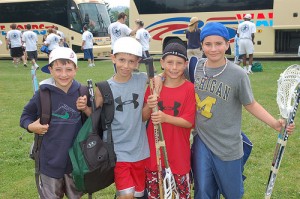 between all this waiting. So although I miss them terribly each summer and usually have several countdowns going at once, I also recognize that the countdown to the hectic long days of the school year with homework, carpooling, sports practices and coordination of schedules is also going on during these precious and fleeting summer weeks.
between all this waiting. So although I miss them terribly each summer and usually have several countdowns going at once, I also recognize that the countdown to the hectic long days of the school year with homework, carpooling, sports practices and coordination of schedules is also going on during these precious and fleeting summer weeks.
So I’m trying to appreciate the waiting. And dare I say, enjoy it. Because before you know it, we’ll all have to endure the longest wait of all… when summer ends and we wait until next summer to do it all over again.
Lisa
Put on Your Swimsuits, Goggles, and Sunblock–It’s Time for a Swim!
Thursday, March 24th, 2011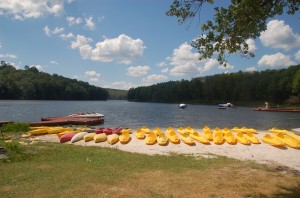 Almost every camper will name his or her waterfront area as one of the best parts of camp. Many camps are built on lakes and their waterfronts play a crucial role during the summer, not only as a place for swimming but as a gathering place and the perfect backdrop for outdoor evening activities. Learning to swim at summer camp is a rite of passage. But learning to swim not only provides a great foundation for building camp memories of sunny days spent at the waterfront, it has lifelong benefits as well.
Almost every camper will name his or her waterfront area as one of the best parts of camp. Many camps are built on lakes and their waterfronts play a crucial role during the summer, not only as a place for swimming but as a gathering place and the perfect backdrop for outdoor evening activities. Learning to swim at summer camp is a rite of passage. But learning to swim not only provides a great foundation for building camp memories of sunny days spent at the waterfront, it has lifelong benefits as well.
Of course, there are the much acclaimed physical and mental benefits that we all know. It’s a great low impact exercise that is suitable for almost everyone, which makes it an ideal part of a regular fitness regime. It’s also not age restrictive. Rather, it’s an activity that can be enjoyed for a lifetime. The fact that muscle strength is also greatly improved as a result of pushing oneself through the water goes without saying.
Swimming also improves coordination, emotional well being, concentration, and social skills. In fact, it’s the largely social aspect of 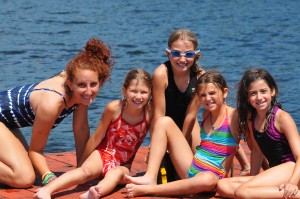 camping that likely makes it such a positive and popular part of the camping experience. The relaxing atmosphere of a pool or waterfront area provides the perfect setting for children to let down their guards and enjoy the type of casual conversation that builds and strengthens friendships. When combined with the sheer fun of the activity, it’s the perfect setting for building memories.
camping that likely makes it such a positive and popular part of the camping experience. The relaxing atmosphere of a pool or waterfront area provides the perfect setting for children to let down their guards and enjoy the type of casual conversation that builds and strengthens friendships. When combined with the sheer fun of the activity, it’s the perfect setting for building memories.
Camp waterfront locations are extremely active and full of almost endless possibilities for campers to experience. There are often several activities taking place at once, which is why camp Waterfront areas are typically generously staffed with well trained, fully certified lifeguards who complete an extensive and rigorous training program prior to the start of camp.
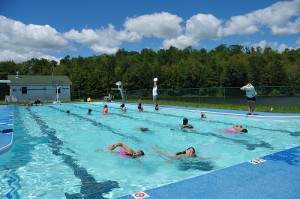 The pool area is not merely a place for swim instruction at summer camp but fun activities such as synchronized swimming competitions in which campers have fun using creativity and teamwork to choreograph a musical number that combines dancing and swimming. Pool parties are popular evening activities at camp, complete with music and plenty of opportunity to socialize.
The pool area is not merely a place for swim instruction at summer camp but fun activities such as synchronized swimming competitions in which campers have fun using creativity and teamwork to choreograph a musical number that combines dancing and swimming. Pool parties are popular evening activities at camp, complete with music and plenty of opportunity to socialize.
Even more adventure can be found on larger lake areas that, in addition to swimming beaches, also often have water toys, such as trampolines, rock-its, and climbing rocks for campers to enjoy. Since these areas require campers to pass a swim test prior to being able to use them, they provide fun and attainable goals for campers: first, to pass the test that allows them to swim to these special areas, then the challenge of climbing the wall or walking the plank. Camps also incorporate their waterfront areas into special event planning. Water games and pirate themed treasure hunts are just a couple of ways that water play is used creatively in camp programs.
Swimming at camp takes on a new level of excitement when included in camp activities–such as decathlons, apache relays, and 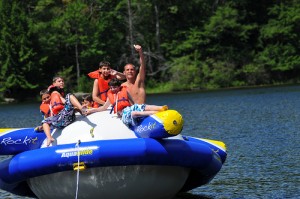 Olympics or Color Wars–that give campers the opportunity to use their swimming skills to rise to a challenge. Many camps also compete in swim meets through their inter camp leagues. Whether racing against other campers or a time clock, being able to apply their swimming instruction in an engaging way and to see firsthand how they’ve improved has been a moment of pride for many a camper.
Olympics or Color Wars–that give campers the opportunity to use their swimming skills to rise to a challenge. Many camps also compete in swim meets through their inter camp leagues. Whether racing against other campers or a time clock, being able to apply their swimming instruction in an engaging way and to see firsthand how they’ve improved has been a moment of pride for many a camper.
So the next time your child regales you with tales of the waterfront at his or her summer camp, remember that it’s not just summer memories that they’re gaining from their swimming experiences, but lifelong skills.
Radio Reminiscing
Thursday, March 17th, 2011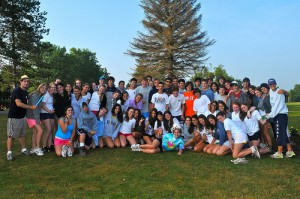 The other day as I was listening to the radio while driving down the road, in the blink of an eye, I was back in the Dining Room surrounded by the voices, noises, and even the smells of Camp Starlight. I love it when those moments happen. Something as simple as one song can transform your mood, surroundings, and energy. Not only do we come across unexpected moments that return us to our summer home away from home, but it creates an excitement, buzz, and energy that I know I can’t shake. When times like that happen, I’ll find myself on the phone or computer reconnected to a long lost camp friend.
The other day as I was listening to the radio while driving down the road, in the blink of an eye, I was back in the Dining Room surrounded by the voices, noises, and even the smells of Camp Starlight. I love it when those moments happen. Something as simple as one song can transform your mood, surroundings, and energy. Not only do we come across unexpected moments that return us to our summer home away from home, but it creates an excitement, buzz, and energy that I know I can’t shake. When times like that happen, I’ll find myself on the phone or computer reconnected to a long lost camp friend.
More importantly, those quick, unexpected instances make me want to return to camp as soon as I possibly can. I am reminded each time those moments happen why I fell in love with Camp Starlight, its campers, and staff twelve years ago. I feel I am one of the fortunate; I have had the opportunity to experience Camp Starlight, and I look forward to the next time I hear a song on the radio that sends me back to camp.
What brings you back?
Sparking Creativity Through Campfire
Tuesday, March 15th, 2011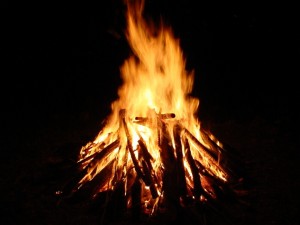 One of the most endearing and sacred parts of summer camp is the campfire. More than just wood lit with a match, it’s an intimate part of the camping experience that goes far beyond simply sitting around a fire. Each camp has a set of traditions uniquely connected to the campfire experience and, to campers, each tradition is significant, demanding reverence. The campfire is the very place where many children recall the moment when their camp transformed from “a camp” to “their camp”, where fellow campers and counselors become family while singing songs, roasting s’mores, and engaging in campfire activities. So intricate is the campfire to the summer camp experience that even former Disney CEO Michael Eisner has reflected on its importance in making him who he is:
One of the most endearing and sacred parts of summer camp is the campfire. More than just wood lit with a match, it’s an intimate part of the camping experience that goes far beyond simply sitting around a fire. Each camp has a set of traditions uniquely connected to the campfire experience and, to campers, each tradition is significant, demanding reverence. The campfire is the very place where many children recall the moment when their camp transformed from “a camp” to “their camp”, where fellow campers and counselors become family while singing songs, roasting s’mores, and engaging in campfire activities. So intricate is the campfire to the summer camp experience that even former Disney CEO Michael Eisner has reflected on its importance in making him who he is:
“Simply consider the lessons I was taught by the campfire…every time the rich reward was the same as we simply sat and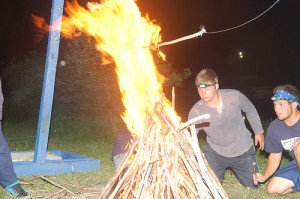 enjoyed our consuming creation. And, there was one aspect in particular that never failed to intrigue me, and that was the process of seeing the single small flame of the match spread to the kindling and then the twigs and then the smaller branches and finally the larger logs. It didn’t dawn on me until years later, but this was the perfect metaphor for the creative process…Years later, I found myself running a network television division and then a movie studio and now an entire entertainment company. But, much of the success I’ve achieved can be traced to the direct and metaphorical
enjoyed our consuming creation. And, there was one aspect in particular that never failed to intrigue me, and that was the process of seeing the single small flame of the match spread to the kindling and then the twigs and then the smaller branches and finally the larger logs. It didn’t dawn on me until years later, but this was the perfect metaphor for the creative process…Years later, I found myself running a network television division and then a movie studio and now an entire entertainment company. But, much of the success I’ve achieved can be traced to the direct and metaphorical
lessons I learned in building those campfires.”
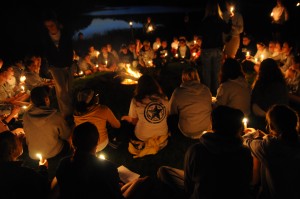 To some, to assign such significance to fire may seem a bit of a stretch. But to anyone who has attended camp, it’s not only believable but apt. Beyond Eisner’s metaphor, the campfire is symbolic of camp, and represents the bonding between campers and nature. Campfires instantly evoke feelings of togetherness and promote an atmosphere of being together in an intimate setting that is unique to the people who are present. Many camps hold opening and closing campfires to welcome campers and immerse them in the camping experience and to help them say goodbye at the end of the summer. At the beginning of the summer, the flames represent the birth of a new summer. Opening campfires often include some sort of ritual that introduces an idea or process that can be re-visited throughout the summer, such as setting goals for the summer or some sort of introduction and bonding activity with camp “siblings”. The meaning of the flames, however, transforms at the end of the summer. The burning of a closing campfire represents the end of the season. It’s a way to give the summer a proper and respectful send off. Campfires held throughout the summer supplement overnight camping trips and special events.
To some, to assign such significance to fire may seem a bit of a stretch. But to anyone who has attended camp, it’s not only believable but apt. Beyond Eisner’s metaphor, the campfire is symbolic of camp, and represents the bonding between campers and nature. Campfires instantly evoke feelings of togetherness and promote an atmosphere of being together in an intimate setting that is unique to the people who are present. Many camps hold opening and closing campfires to welcome campers and immerse them in the camping experience and to help them say goodbye at the end of the summer. At the beginning of the summer, the flames represent the birth of a new summer. Opening campfires often include some sort of ritual that introduces an idea or process that can be re-visited throughout the summer, such as setting goals for the summer or some sort of introduction and bonding activity with camp “siblings”. The meaning of the flames, however, transforms at the end of the summer. The burning of a closing campfire represents the end of the season. It’s a way to give the summer a proper and respectful send off. Campfires held throughout the summer supplement overnight camping trips and special events.
To say that the campfire breeds creativity is not only accurate, but understated. The various representations and 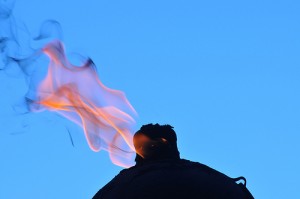 meanings that the actual fire itself takes on helps campers learn to look at the same thing from different angles, a crucial aspect of honing creative thought and learning to think “outside the box”, which is essential to developing good problem solving skills. When considered from this perspective, it’s not at all difficult to imagine a CEO of one of the world’s largest companies crediting much of his success to his camp experiences, specifically to the campfire. In fact, it provides insight about the significance of camp and how the lessons learned there can be carried throughout life.
meanings that the actual fire itself takes on helps campers learn to look at the same thing from different angles, a crucial aspect of honing creative thought and learning to think “outside the box”, which is essential to developing good problem solving skills. When considered from this perspective, it’s not at all difficult to imagine a CEO of one of the world’s largest companies crediting much of his success to his camp experiences, specifically to the campfire. In fact, it provides insight about the significance of camp and how the lessons learned there can be carried throughout life.
1,3,5,6 We Want Olympics!
Thursday, March 10th, 2011Over several decades, across many miles, and in the heart of campers of all ages lies the excitement of arguably the most 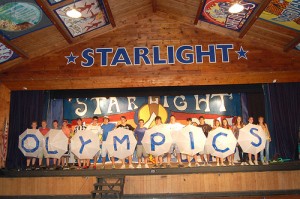 anticipated event of the summer. When will it happen? Who will be our leadership? What team will I be on? These questions echo in the minds of campers and counselors alike throughout the school year, and they only grow more intense as the summer progresses. So what is this hallowed event that has everyone’s attention? And what is it about this event that has everyone so excited?
anticipated event of the summer. When will it happen? Who will be our leadership? What team will I be on? These questions echo in the minds of campers and counselors alike throughout the school year, and they only grow more intense as the summer progresses. So what is this hallowed event that has everyone’s attention? And what is it about this event that has everyone so excited?
Well, at Camp Starlight we call this thrilling week of spirit and competition Olympics! Our campers and staff pass many a spare moment over the year thinking about what the team names will be, who will be the officers and captains, and what the theme for Sing will be. Once the summer kicks off, and the weeks begin to pass, whispers about when it will break can be heard around camp.
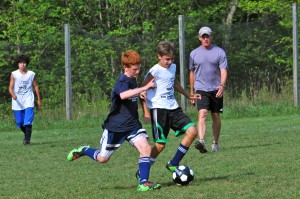 But as anyone who has spent a summer at Starlight will tell you, Olympics is an exhilarating week of athletic, strategic, and academic competition. Whether your strength is playing on the soccer field, catching cheese balls on your shaving cream laden head, or having the fastest buzzer pressing thumb in Wayne County, your team will be depending on your contribution! From the second Olympics breaks to the moment your feet hit the lake after the final scores are announced, the electrifying spirit of the Blue and the White can be felt in the air. At Starlight, there is no doubt that we truly do justice to the time honored tradition shared by summer camps around the country and passed down over many years.
But as anyone who has spent a summer at Starlight will tell you, Olympics is an exhilarating week of athletic, strategic, and academic competition. Whether your strength is playing on the soccer field, catching cheese balls on your shaving cream laden head, or having the fastest buzzer pressing thumb in Wayne County, your team will be depending on your contribution! From the second Olympics breaks to the moment your feet hit the lake after the final scores are announced, the electrifying spirit of the Blue and the White can be felt in the air. At Starlight, there is no doubt that we truly do justice to the time honored tradition shared by summer camps around the country and passed down over many years.
So the next time you catch yourself daydreaming of smearing on your face paint 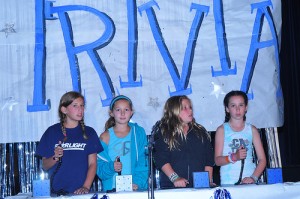 or spraying your hair in your team’s shade, know that there is another Starlighter somewhere sharing in your excitement and anticipation. So until we’re back together facing off on the fields, dodging gigs in our seats, and handing off the baton, make sure to keep “B-L-U-E, we got the spirit!” and “We are the white team! Couldn’t be prouder!” fresh in your thoughts!
or spraying your hair in your team’s shade, know that there is another Starlighter somewhere sharing in your excitement and anticipation. So until we’re back together facing off on the fields, dodging gigs in our seats, and handing off the baton, make sure to keep “B-L-U-E, we got the spirit!” and “We are the white team! Couldn’t be prouder!” fresh in your thoughts!
Shout Out from Schumer
Thursday, March 3rd, 2011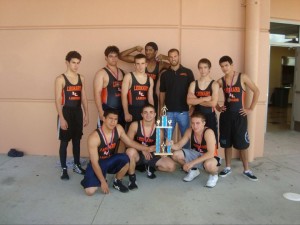 Camp Starlight Boy’s Athletic Director, Adam Schumer, recently checked in to let us know what he has been up to and gave us a couple of exercises to help us train for the 2011 Slope for Lope.
Camp Starlight Boy’s Athletic Director, Adam Schumer, recently checked in to let us know what he has been up to and gave us a couple of exercises to help us train for the 2011 Slope for Lope.
After Camp; Adam returned to his job as an elementary physical education teacher at Forest Hill Elementary School in Palm Beach County, Florida. Adam is extremely busy as the coach of the John I. Leonard High School Wrestling team. His team recently won the Palm Beach Gardens duals, and they have seen remarkable improvement across all weight classes. Adam and his team look forward to the regional, district, and state tournaments.
To keep active during the off-camp season, Adam participates in a number of athletic events. He ran in the Palm Beaches Marathon Festival, where he finished near the top of his age group this past December. Adam also participates in various Adventure Races across Florida. These races include canoeing, biking, and running. Participants are given a map and are required to check in at various points as they make their way through the course. Adam plans to bring this Adventure Race concept to Starlight this summer.
Adam says the winter season is the perfect time to move your exercise routine indoors, and he suggested a couple of fun winter activities for campers. Younger campers should start practicing some of your favorite circus tricks, such as hula hooping, juggling, or jumping rope (if you have high ceilings). Just make sure you’ve got enough space and don’t damage any of your parents’ favorite furniture! Older campers, keep up the yoga and pilates. They are great for strengthening muscles, improving flexibility,and lowering stress from homework and exams. They’re also easy and inexpensive activities that you can do just about anywhere in your house.
Hopefully these drills help out, and he can’t wait to see you at Camp in June!
Summer Camp and Child Development
Tuesday, December 14th, 2010“The organized summer camp is the most important step in education that America has given the world.”
Charles W. Eliot, former president of Harvard University, 1922
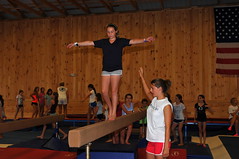 If you’ve been following this blog for a while, you know that we’ve focused a lot on how much fun kids have at camp — learning new sports; spending time with friends old and new; going on amazing trips; connecting with friends and counselors. But camp is also an educational experience for the children. We’re so used to education being “school” that it’s a real shift in perception to see lacrosse, tennis, living in a bunk, and other camp activities as education; but educational activities they are, as many parents can attest now their kids are back in school!
If you’ve been following this blog for a while, you know that we’ve focused a lot on how much fun kids have at camp — learning new sports; spending time with friends old and new; going on amazing trips; connecting with friends and counselors. But camp is also an educational experience for the children. We’re so used to education being “school” that it’s a real shift in perception to see lacrosse, tennis, living in a bunk, and other camp activities as education; but educational activities they are, as many parents can attest now their kids are back in school!
Summer camps make a huge difference in the year-round education of our children, but it may require a shift in our thinking about what education is and can be. The American Academy of Pediatrics, alongside many other scholars of child development, explains why, as “Play is essential to development as it contributes to the cognitive, physical, social, and emotional well-being of children and youth.” Our kids learn while playing and they are learning important things about themselves as independent social beings, collaboratively working with others and consequential behaviors such as self reliance, responsibility and accountability.
 So what kind of difference can summer camp make to your child’s development? As the Executive Director of the American Camp Association, Peg Smith has been telling the world for years, opportunities for growth and development exist in natural settings that promote experiential learning, improve social skills and physical fitness, teach children to take calculated risks in a safe environment, and expand the creative mind. The environment our kids learn in is important, and nothing beats Nature.
So what kind of difference can summer camp make to your child’s development? As the Executive Director of the American Camp Association, Peg Smith has been telling the world for years, opportunities for growth and development exist in natural settings that promote experiential learning, improve social skills and physical fitness, teach children to take calculated risks in a safe environment, and expand the creative mind. The environment our kids learn in is important, and nothing beats Nature.
As you can see, summer camp is one of the most precious educational gifts you can give your children. If you would like to read more, check out The Experiential Classroom: Camp (3/10) by Marla Coleman in The American Camping Association’s Camping magazine. We’d also like to hear what you believe summer camp has taught you and your children! Please feel free to share in the comments section below.
Susan




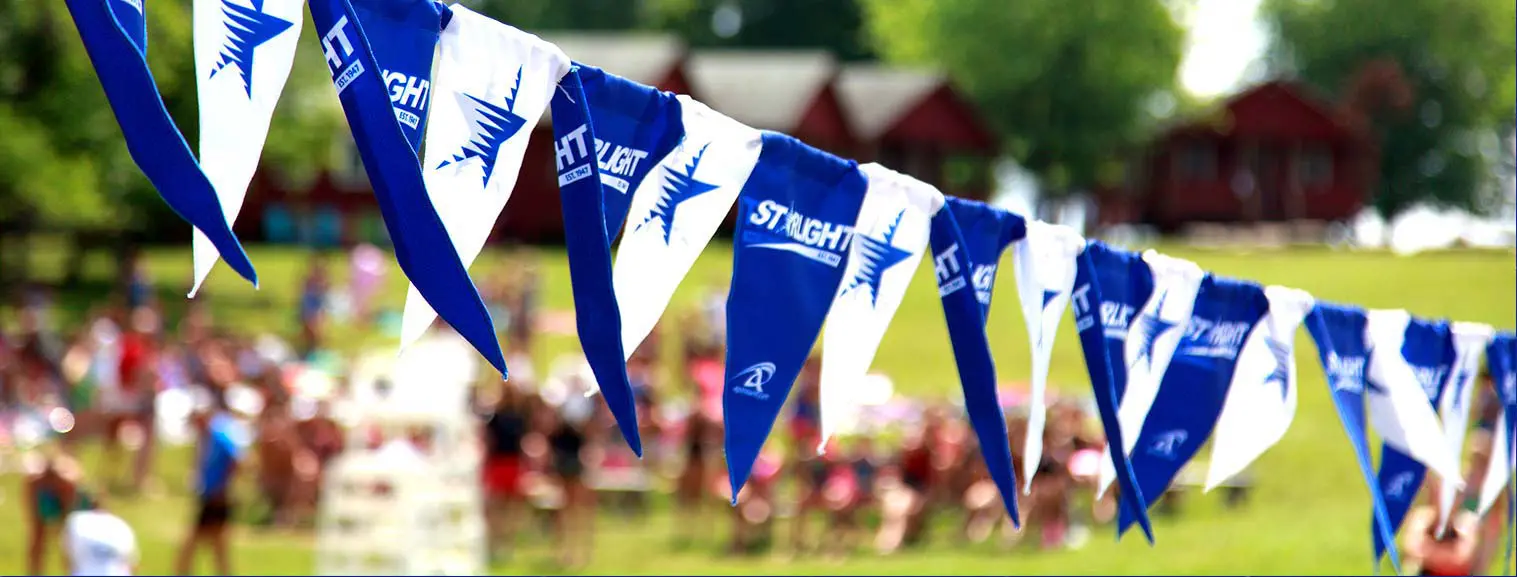
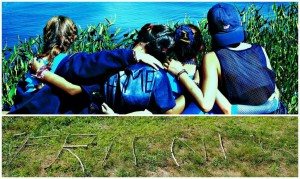
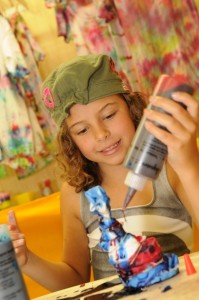
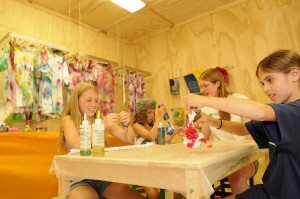
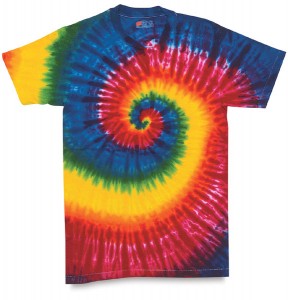
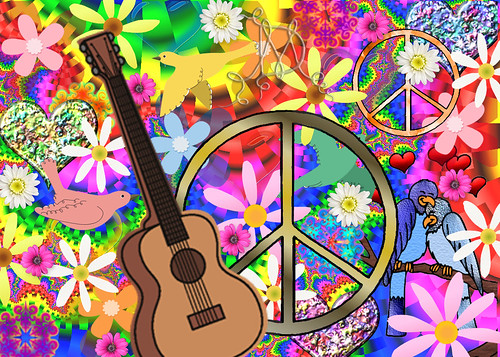 When I think about “camp songs,” I immediately think about singing around campfires, but each year at camp also has a distinct popular music soundtrack. Recently, campers weighed in on Twitter about the tunes that remind them of past summers and that got me thinking about what the United States and camp was like in the 1960s and 1970s.
When I think about “camp songs,” I immediately think about singing around campfires, but each year at camp also has a distinct popular music soundtrack. Recently, campers weighed in on Twitter about the tunes that remind them of past summers and that got me thinking about what the United States and camp was like in the 1960s and 1970s.
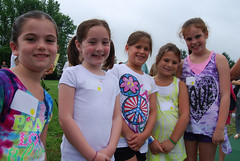 assumptions can be challenged, and where diverse people find ways to celebrate community and appreciate each other. One great thing about camp is that for a few weeks, the world grows a little smaller and everyone listens to the same soundtrack. In a fast-paced and interconnected world, camp “sounds” like the perfect place for connecting with others and as Hadley says, every summer adds up to “good times for campers and staff.” It’s often only later that campers realize how much the experience has shaped them and the way they see the world–much like how hit songs can illuminate the past in retrospect. The music (and fashions) may change through the years, but the core camp experience never goes out of date.
assumptions can be challenged, and where diverse people find ways to celebrate community and appreciate each other. One great thing about camp is that for a few weeks, the world grows a little smaller and everyone listens to the same soundtrack. In a fast-paced and interconnected world, camp “sounds” like the perfect place for connecting with others and as Hadley says, every summer adds up to “good times for campers and staff.” It’s often only later that campers realize how much the experience has shaped them and the way they see the world–much like how hit songs can illuminate the past in retrospect. The music (and fashions) may change through the years, but the core camp experience never goes out of date.